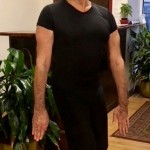The 100 … Is there another way up the mountain?
by Swami Doug Bentz
December 5, 2018
So here we go, once again into the fray! Another Swami Doug “challenge” to the status quo … sorry! 😉
I realize this article might upset some people, and that is not my intention at all. I mean this as simply “food for thought” for those Pilates teachers, and practitioners as well, that love the work and are dedicated to teaching/practicing it to the best of their abilities. But that may, at the same time, be having problems with getting the intended benefits from the standard exercise called The 100 – an exercise seen as a building block for Pilates work, but that certainly has its “obstacles” for certain bodies, age ranges and medical issues.
Teaching people how to develop a strong and deeply engaged core is both challenging and rewarding for the Pilates teacher and client alike. It is certainly an important goal in Pilates as well as other fitness regimens. But is it ALWAYS the first choice?
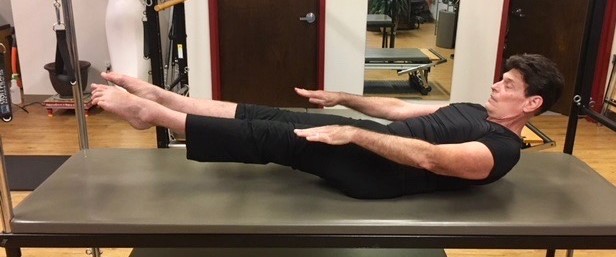
I am simply offering an alternate version of the standard 100 for clients that simply can NOT perform it well yet at all, are NOT getting the benefit we want for them from it, or are facing the fact that it is just NOT good for them for a variety of physical or medical reasons.
Consider two very different types of clients:
- Those who may be carrying some extra ‘padding’ around the waist and stomach area.
- Those that are evidencing an overly-kyphotic posture with a forward shearing of the skull due to either medical issues, age, genetics, bad posture habits, too much sitting at a computer and/or super heavy backpacks hanging off their shoulders. (Hello! Look around you these days.)
In frustration, I find myself asking: “How can I better help these hunched-over or overweight clients, whether old or young, that are struggling to stay up in The 100 shape for a long time without excessive neck strain, frustration, discouragement … and in reality showing no real improvement towards the goal of achieving that flat belly/deep abdominal scoop feeling that is a hallmark of Pilates work … and that sleek “look” so often seen on social media?“
The shape itself can be reinforcing a kyphotic posture for many of them, and also cause extreme neck tension! How many props does one have to resort to in order to force the client to match the pictures in the brochure? When in fact there might be more accessible and more effective ways to bring these kinds of clients to this very goal, without putting them through unnecessary agony … and thereby losing them as clients! As the old saying goes: “There are many ways up the mountain.”
And there are ample examples of flexion work in the Pilates rep following the standard 100, right?
I have been working on this idea for several years with my pre-professional college dancers and my Pilates clients that just cannot do the 100 … but want this work desperately!
I submit to you for your own exploration: The Standing 100. Ta da!
The 100 performed standing either in Pilates ‘V’ foot position with the heels down (or with heels lifted just 1/2 inch) or in a parallel foot position with a yoga block ‘hugged’ between the big toe joints and the medial malleolus (inner ankle).
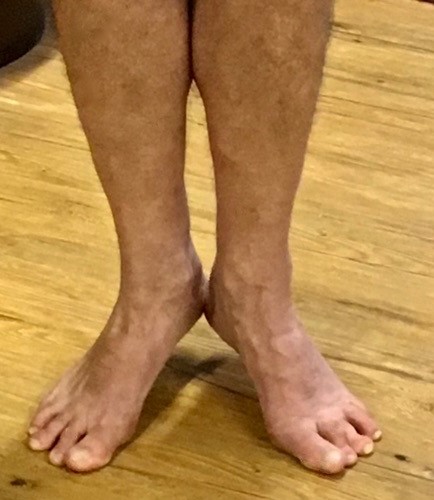
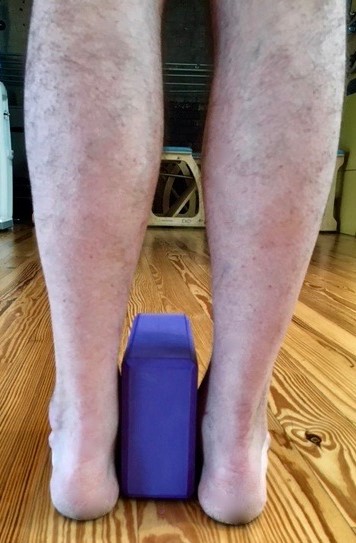
The first brings a fabulous challenge to whole body stability and balance while the second offers a great sensation of that long inner thigh connection we all talk about … but it is not so easy for clients to actually feel themselves! The inner thigh connection is SO important for standing balance work … something a lot of people really need help with. And it reinforces rising up through the middle toes and big toe for secure balance moving through the talus to the metatarsals.
In The Standing 100 (in reality, it’s a standing 150), I use the standard 10 arm pumps coordinated with the 5 count inhale and the 5 count exhale. However, I have clients do 5 sets in upper spine flexion, then 5 sets in neutral spine, then 5 sets in upper spine extension.
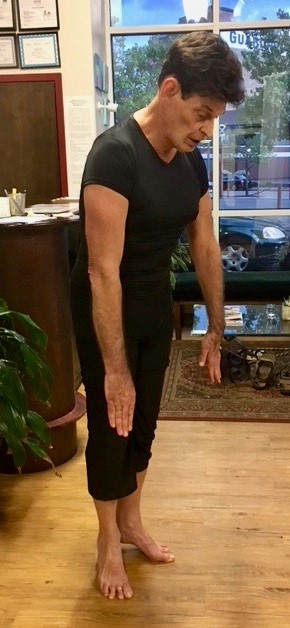
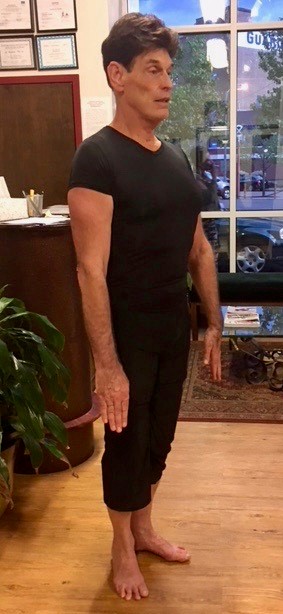
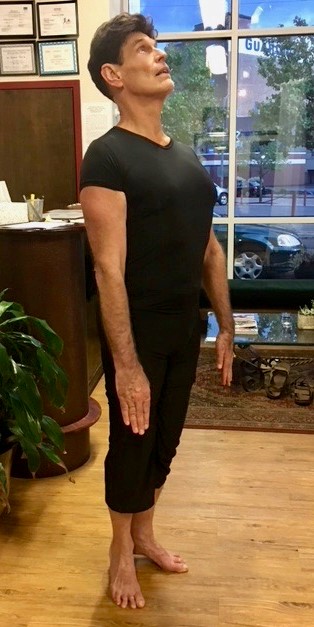
They can do this in one long flow, shifting into the next shape with the next 5 count inhaling sequence. Or each segment can be done separately with the change made in between. You can also lower the heels back to the floor in between sequences.
As for the cervical/neck flexion aspect, I ask them to imagine holding an egg under their throat and to try not to crush it! Easy to image for them and allows that lovely throat opening/mastoid process curl that keeps the throat open with no strain in the neck.
You can see how strong or weak their arm pumps are, and if they are actually inhaling and exhaling deeply throughout … and not just lip breathing. It can really enhance the 2-way Pilates stretch in the body, the upper torso curl and the deep belly scoop without the accompanying neck strain. It also helps the client understand the concept of bringing the back body and the front body together in the center … especially for dancers who tend to be front body open with ribs flared!
Plus, it introduces them to standing and working on their feet and legs in gravity and really integrates their legs up into the body! It is also a nice change of pace for clients accustomed to always starting their sessions laying on their backs looking up at the ceiling.
There are lots of options here and lots of experiential learning and client feedback opportunities. You can change the length of each sequence, or change the breathing pattern, or just focus on one of the sequences. You can also challenge and/or extend The Standing 100 into spinal rotation by twisting around on either side or by standing on one leg and then the other for each sequence. Although this final adaptation is best performed with parallel feet and heels down on the floor/mat.
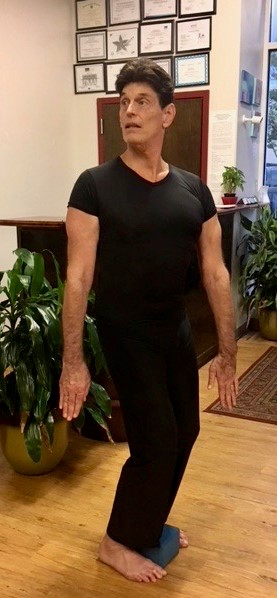
Before you haul me up and burn me at the stakes, try it! I have found some of my clients LOVE this and later are quite ready to transpose the Standing 100 to the classic 100 with less strain, more fun in exploring the work, some welcome laughter, and continued booking for Privates! Be well. Be happy.
There are indeed many ways up the mountain … and we are all climbing, eh?

Doug Bentz lives in Pittsburgh, PA, has a BA in Dance from Butler University in Indianapolis, was a Dance Professor in the Conservatory of Performing Arts at Point Park University for 40 years, and has enjoyed a 49 year professional dance career with companies such as the Ballet du Grand Theatre in Geneva, Switzerland, the New Jersey Ballet, the Luigi Jazz Dance Company in NYC, the Pittsburgh Ballet Theatre, the American Dance Ensemble, the Pittsburgh Dance Alloy, and his own Pittsburgh-based company The Extension. Doug has also performed in over 30 musicals both on and off Broadway, in Georgia, Michigan, Florida, and with the Kenley Players of Ohio as a member of the Actors’ Equity Association.
Doug was a scholarship student at the School of American Ballet in NYC and also studied yoga at the Kripalu Institute. He has practiced and taught yoga for 25 years. Doug has also choreographed over 60 original dance works including: The Jazz Nutcracker, Allegro Jazzioso, Let’s Swing, The Snow Queen, Dragana, Arc of Descent, Transmigration of Souls, Folie a Deux, American Gothic and MoonDance.
Swami Doug is a PMA-CPT certified Pilates teacher and did his Comprehensive Teacher Training at Harmony Pilates in Pittsburgh, PA. He has taught Pilates as an Independent Contractor at Moxie Mind & Body Pilates, the Wexford Oxford Athletic Club and is currently teaching at the SThiel Pilates & MOVEment Center in Pittsburgh.

